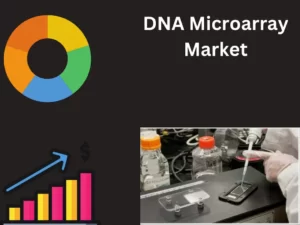DNA Microarray Market Size, Production, Sales, Average Product Price, Market Share, Import vs Export

- Published 2025
- No of Pages: 120+
- 20% Customization available
DNA Microarray Market Trends and Drivers: A Comprehensive Analysis
The DNA Microarray Market has seen significant growth in recent years, propelled by advancements in biotechnology and the increasing demand for genomic research. The market’s evolution has been shaped by multiple factors, including the rise of personalized medicine, the increasing prevalence of genetic disorders, and advancements in microarray technology itself. As we continue to witness a surge in both public and private investments, the DNA Microarray Market is poised for further expansion, with new applications, emerging technologies, and a rising demand for precision healthcare shaping the industry’s future.

DNA Microarray Market Expansion: Growth in Research Applications
The DNA Microarray Market has seen tremendous growth in its application across various research domains, particularly in genomics and disease diagnosis. Genomic research has witnessed rapid development, with microarrays playing a pivotal role in gene expression analysis. This growth is reflective of the heightened global focus on understanding the genetic basis of diseases and the underlying mechanisms that drive them. A crucial driver in this growth is the increasing emphasis on understanding diseases at a molecular level, which has led to increased funding and research in the field of genomics. For instance, advancements in cancer research have relied heavily on DNA microarrays, helping researchers identify genetic markers and pathways crucial for early diagnosis and personalized treatment plans.
Growing Demand for Personalized Medicine and Precision Healthcare
Personalized medicine is one of the primary factors driving the DNA Microarray Market, as it allows for the development of tailored treatment plans based on an individual’s genetic makeup. This trend is expected to increase in the coming years, fueled by a deeper understanding of how genetic variations affect individual responses to drugs. As precision medicine continues to gain momentum, the DNA Microarray Market is witnessing a parallel surge in demand. The ability of microarrays to detect variations in gene expression has made them invaluable tools for pharmacogenomics, a field that aims to tailor drug therapies based on genetic profiles.
DNA Microarray Market Size Expansion: Technological Advancements
Technological advancements in DNA microarray technology have also contributed to the significant expansion of the market. The introduction of high-density microarrays, with the ability to analyze thousands of genes simultaneously, has revolutionized genetic research and diagnostics. The increasing sensitivity and accuracy of these devices have made them indispensable tools in the fields of diagnostics, biotechnology, and drug discovery. The growing availability of more advanced platforms, such as next-generation sequencing (NGS), combined with DNA microarrays, has further enhanced their utility in both clinical and research settings. These advancements have paved the way for the wider adoption of microarray technology, driving the overall growth of the DNA Microarray Market.
DNA Microarray Market in Disease Diagnostics: A Game-Changer
The DNA Microarray Market has found significant applications in disease diagnostics, where its ability to analyze gene expression patterns has led to more accurate, timely, and efficient diagnosis of various diseases. For example, in cancer diagnostics, DNA microarrays are increasingly being used to detect specific genetic alterations that can predict the likelihood of a patient developing cancer. This ability to identify biomarkers has revolutionized the way doctors diagnose and treat patients, especially those with complex or rare diseases. In fact, studies have shown that the use of DNA microarrays in early cancer detection has significantly improved patient outcomes, making them an indispensable part of modern diagnostic practices.
Furthermore, the ability of microarrays to identify genetic mutations has made them an essential tool in the diagnosis of genetic disorders, such as cystic fibrosis, Duchenne muscular dystrophy, and Alzheimer’s disease. The growing awareness of the importance of early genetic testing has led to an increase in the demand for DNA microarrays, further driving the growth of the market.
Regulatory Support and Funding: Key Drivers of the DNA Microarray Market
One of the key drivers of the DNA Microarray Market is the strong regulatory support and funding from both government and private entities. Various governmental bodies, including the National Institutes of Health (NIH) in the U.S. and the European Commission, have funded large-scale research projects that leverage DNA microarrays to advance the understanding of diseases and develop innovative treatment options. These initiatives, coupled with the expanding number of grants aimed at supporting genomic research, have provided the DNA Microarray Market with a solid foundation for growth.
For example, the U.S. government’s initiatives to fund genomic research, such as the Human Genome Project, have played a significant role in fostering the development of DNA microarray technology. As funding continues to flow into genetic research, the DNA Microarray Market is expected to benefit from the continued advancement of technology, as well as the increased availability of affordable microarray products.
Increasing Adoption in Agriculture: The Expanding DNA Microarray Market
Another emerging trend driving the DNA Microarray Market is its expanding application in agriculture. Researchers are increasingly using microarrays to analyze gene expression in crops, enabling them to identify desirable traits and improve crop yield and resistance to diseases. For instance, DNA microarrays have been employed to enhance the development of genetically modified crops, such as drought-resistant maize and pest-resistant cotton. This shift towards incorporating DNA microarray technology into agriculture has opened up new revenue streams for the market, highlighting the versatility of microarrays beyond traditional genomic research.
Moreover, the growing demand for sustainable farming practices, coupled with the need for greater food security, has intensified the application of DNA microarrays in agricultural research. As the global population continues to grow, the need for high-yield, disease-resistant crops becomes even more critical. DNA microarrays are playing a key role in addressing these challenges by enabling scientists to accelerate the breeding of improved crops, thus driving demand for microarray technology in the agricultural sector.
DNA Microarray Market Challenges: Addressing the High Costs and Complexity
Despite the significant growth opportunities, the DNA Microarray Market faces challenges, particularly in terms of the high costs associated with microarray platforms and the complexity of data analysis. While the technology itself has become more accessible over time, the cost of acquiring and maintaining DNA microarray systems can still be prohibitive, particularly for small-scale laboratories or research facilities. Furthermore, the large volumes of data generated by DNA microarray experiments require advanced bioinformatics tools and expertise to analyze, which can also present a barrier to adoption in certain regions.
However, advancements in software tools designed to streamline the data analysis process are gradually mitigating these challenges, making DNA microarrays more accessible and easier to use. As the technology continues to evolve, it is expected that both the costs associated with DNA microarray systems and the complexity of data interpretation will decrease, allowing for broader adoption across various industries.
The Future of the DNA Microarray Market: A Promising Outlook
Looking forward, the DNA Microarray Market is poised for continued growth, driven by technological advancements, increased research funding, and the growing demand for precision medicine. As DNA microarrays continue to evolve, their applications are expanding into new fields such as microbiome research, environmental science, and personalized nutrition. This diversification of applications suggests that the DNA Microarray Market will experience sustained growth over the next decade.
Moreover, as the healthcare industry continues to prioritize personalized treatment plans and early disease detection, the demand for DNA microarrays will continue to rise, further cementing their position as critical tools in the genomics space. With ongoing advancements in microarray technology and a growing recognition of its importance in various research and diagnostic applications, the DNA Microarray Market is set to thrive in the years to come.
“Track Country-wise DNA Microarray Production and Demand through our Database”
-
-
- DNA Microarray sales volume database for 27+ countries worldwide
-
Geographical Demand in the DNA Microarray Market: A Global Perspective
The geographical demand for DNA microarrays is experiencing varied growth across regions, largely driven by regional research advancements, healthcare investments, and the increasing prevalence of genetic disorders. North America, Europe, and Asia-Pacific represent the primary demand drivers in the global DNA Microarray Market, with distinct factors propelling growth in each region. North America, particularly the United States, has consistently been a leader in the demand for DNA microarrays, largely due to the presence of a robust healthcare infrastructure and significant investments in genomic research. The growth in demand is supported by the ongoing expansion of personalized medicine, where DNA microarrays play an instrumental role in identifying genetic biomarkers for targeted treatment plans.
In Europe, the demand for DNA microarrays is expanding due to a rising focus on genetic testing and the increasing number of research initiatives funded by both government and private entities. The European market is benefitting from advancements in genomic technologies, which are enhancing the applicability of DNA microarrays in areas like oncology, pharmacogenomics, and genetic disorders. Countries like the UK, Germany, and France are leading the charge in terms of investments and research in genomics, thereby increasing the demand for DNA microarray systems.
The Asia-Pacific region is witnessing the fastest growth in the DNA Microarray Market, largely driven by an increase in healthcare awareness, government support for biotechnology research, and growing investments in genomics. Countries such as China, India, and Japan are increasingly adopting DNA microarrays in clinical and research settings. For instance, China has made significant strides in genomic research and the adoption of DNA microarray technology in personalized medicine and agricultural biotechnology. As healthcare spending continues to rise in this region, the demand for DNA microarrays is expected to grow exponentially.
DNA Microarray Manufacturing: Technological Advancements and Regional Production Trends
DNA microarray manufacturing is a critical component of the overall market, directly influencing the availability and cost-effectiveness of microarrays across different regions. Over the years, advancements in DNA microarray manufacturing processes have led to improved chip designs, higher density arrays, and enhanced accuracy in gene expression analysis. These advancements are driving the growth of the DNA Microarray Market by increasing the efficiency and scalability of microarray production.
Manufacturers of DNA microarrays are increasingly focusing on improving the versatility of their products, catering to a wide range of applications such as diagnostics, drug discovery, and agriculture. High-density microarrays, for instance, allow for the simultaneous analysis of thousands of genes, making them particularly useful in large-scale genomic studies. Additionally, the integration of microarrays with next-generation sequencing technologies is pushing the boundaries of what can be achieved in genetic research, and manufacturers are working to make these hybrid solutions more accessible to both research institutions and clinical labs.
The manufacturing landscape of DNA microarrays is also witnessing a shift towards regional production. While North America and Europe have traditionally been the largest producers of DNA microarrays, manufacturers in the Asia-Pacific region are becoming increasingly competitive due to lower production costs and rising demand from local markets. For example, China has emerged as a significant player in DNA microarray manufacturing, with companies developing high-quality products at more affordable prices. This shift is helping to meet the growing demand for DNA microarrays in regions like Asia-Pacific, where the healthcare infrastructure is expanding rapidly.
DNA Microarray Market Segmentation: Applications Driving Growth
The DNA Microarray Market is segmented into several key application areas, each contributing to the market’s growth trajectory. The primary segments driving the market include diagnostics, drug discovery, agricultural biotechnology, and research and development.
In diagnostics, DNA microarrays are used to detect genetic disorders, cancer, and infectious diseases. As mentioned earlier, the role of DNA microarrays in early disease detection is revolutionizing the way genetic testing is conducted, especially in oncology. With increasing prevalence rates of cancer and genetic disorders, the demand for DNA microarrays in diagnostic applications is expected to continue to rise.
In the drug discovery segment, DNA microarrays play a vital role in identifying potential drug targets and understanding drug mechanisms. With the growing demand for personalized medicines, DNA microarrays are increasingly being used to identify genetic variations that could influence how patients respond to specific treatments. This trend has led to a steady increase in demand for microarray technology in pharmaceutical R&D.
In agricultural biotechnology, DNA microarrays are becoming indispensable tools in the identification of genetically modified crops and the analysis of plant genes for improving yield, disease resistance, and drought tolerance. The application of DNA microarrays in agriculture is projected to grow significantly as the global demand for food security and sustainable farming practices intensifies.
Research and development also remains a dominant segment, particularly in academic and government research. DNA microarrays continue to play a key role in large-scale genomic studies aimed at understanding the molecular basis of diseases, drug responses, and genetic variation across populations. The growing interest in precision medicine and molecular research is driving an increased demand for DNA microarrays in this segment.
Price Trends in the DNA Microarray Market: A Shift Towards Affordability and Accessibility
As the DNA Microarray Market expands, price trends are evolving in response to technological advancements and increased competition among manufacturers. Historically, the cost of DNA microarrays was a significant barrier to their widespread adoption, particularly in regions with limited research budgets. However, over the past decade, the price of DNA microarrays has decreased substantially due to advancements in manufacturing technology and economies of scale. The shift towards high-density arrays, which can simultaneously analyze thousands of genes, has helped reduce the overall cost per test, making DNA microarrays more accessible to a wider range of research institutions and clinical labs.
This reduction in cost is particularly important in regions like Asia-Pacific and Latin America, where healthcare budgets are smaller, but demand for genetic testing and molecular diagnostics is on the rise. The increasing affordability of DNA microarrays is expected to lead to greater adoption in these regions, further driving market growth.
Furthermore, the competitive landscape of DNA microarray manufacturing is contributing to price reductions. As more manufacturers enter the market, particularly in countries like China and India, the level of competition has risen, leading to more cost-effective solutions for end-users. The trend towards outsourcing production to countries with lower labor costs is also contributing to price reductions, making DNA microarrays more affordable for academic and commercial users alike.
Impact of Regulatory Policies on DNA Microarray Manufacturing and Pricing
Regulatory policies have a significant influence on both the pricing and manufacturing of DNA microarrays. In developed regions such as North America and Europe, the demand for highly regulated and standardized DNA microarray products is strong, as end-users seek assurance of product reliability, accuracy, and consistency. These regulatory standards can sometimes increase the cost of DNA microarrays, as manufacturers must invest in meeting rigorous quality assurance protocols and obtaining necessary certifications. However, these regulations also ensure that the products entering the market are of the highest quality, thus driving confidence in their application across critical sectors such as healthcare and agriculture.
In contrast, the regulatory environment in emerging markets such as India and China is relatively less stringent, which has allowed local manufacturers to offer more affordable DNA microarrays. While this has helped drive growth in these regions, it also poses challenges in terms of ensuring product quality and consistency. As regulatory standards continue to evolve globally, manufacturers will need to navigate a delicate balance between cost-effectiveness and compliance with increasingly stringent regulations.
Future Outlook: DNA Microarray Market Growth and Market Shifts
Looking ahead, the DNA Microarray Market is expected to continue its upward trajectory, driven by increasing demand for genomic research, diagnostic applications, and agricultural biotechnology. As regional demand grows, especially in emerging markets, the shift toward local manufacturing and more competitive pricing will make DNA microarrays more accessible to a broader range of consumers.
The segmentation of the DNA Microarray Market will continue to evolve, with applications in precision medicine and drug discovery playing an increasingly prominent role. As technology improves and the cost of production decreases, DNA microarrays will become more versatile and widely adopted across a range of industries. With ongoing advancements in manufacturing processes and the continuous expansion of application areas, the DNA Microarray Market is set to experience sustained growth in the years to come.
“DNA Microarray Manufacturing Database”
-
-
- DNA Microarray top manufacturers market share for 27+ manufacturers
- Top 7 manufacturers and top 17 manufacturers of DNA Microarray in North America, Europe, Asia Pacific
- DNA Microarray sales dashboard, DNA Microarray sales data in excel format
-
Leading Manufacturers in the DNA Microarray Market
The DNA Microarray Market is shaped by several key players who have significantly influenced its growth through innovation, strategic partnerships, and the introduction of advanced technologies. These companies provide a wide array of products catering to different applications, from gene expression analysis to disease diagnostics and personalized medicine.
Thermo Fisher Scientific Inc.
Thermo Fisher Scientific Inc. is a leading player in the DNA Microarray Market, offering a comprehensive range of solutions that are widely used in genomics, diagnostics, and research. Their GeneChip™ system is a cornerstone of their product portfolio, enabling users to conduct gene expression profiling and genotyping. The GeneTitan™ system automates high-throughput microarray analysis, making it an essential tool for large-scale studies. The Affymetrix™ microarray kits are popular for their wide application in academic research, clinical diagnostics, and pharmacogenomics. Thermo Fisher Scientific Inc. is known for its cutting-edge technology that enhances the efficiency of genomic research and diagnostics.
Illumina, Inc.
Illumina, Inc. is another dominant player in the DNA Microarray Market, known for its high-throughput sequencing technologies and microarray solutions. The Infinium™ microarray kits from Illumina offer an efficient platform for genotyping and epigenetic studies, providing researchers with detailed genetic information. The Infinium MethylationEPIC Kit, designed for epigenetic research, provides extensive coverage of CpG islands, making it indispensable in cancer research and other genetic disorder studies. Illumina’s products are integral to personalized medicine, offering high-performance solutions that are widely used in clinical diagnostics and research.
Agilent Technologies, Inc.
Agilent Technologies, Inc. plays a significant role in the DNA Microarray Market with its advanced product offerings aimed at gene expression analysis and genotyping. The SurePrint G3 Microarrays are known for their high-density arrays, which are ideal for large-scale genomic studies. Agilent also offers the SureSelect Target Enrichment System, a tool designed for targeted sequencing applications. These products are widely used in functional genomics, biomarker discovery, and diagnostic research. Agilent’s commitment to delivering innovative, high-quality products makes it a key player in the market.
PerkinElmer, Inc.
PerkinElmer, Inc. is another key manufacturer in the DNA Microarray Market, offering a range of solutions for gene expression and genotyping. The company’s OneArray® microarrays are used for comprehensive genomic analysis, particularly in research on gene function and genetic variation. PerkinElmer’s chemiluminescent microarray kits are designed for a range of genomic applications, including genetic screening and diagnostics. The company’s products are crucial in advancing personalized medicine, with a focus on improving the sensitivity and throughput of genomic analysis.
QIAGEN N.V.
QIAGEN N.V. offers a range of microarray products that support a wide variety of genomic applications. Their GeneReader NGS system integrates next-generation sequencing with microarray technologies, enabling efficient and high-quality genomic analysis. QIAGEN also offers the QIAseq Targeted RNA Panels for gene expression analysis, which are highly valuable in understanding genetic variation and its role in diseases. With a focus on delivering innovative solutions for clinical diagnostics and research, QIAGEN continues to play a critical role in advancing genomic science.
Manufacturer Market Share in the DNA Microarray Market
The DNA Microarray Market is highly competitive, with several leading players holding significant market shares. Thermo Fisher Scientific Inc., Illumina, Inc., Agilent Technologies, Inc., PerkinElmer, Inc., and QIAGEN N.V. dominate the global market, with Thermo Fisher Scientific leading with the largest market share. As of recent estimates, Thermo Fisher Scientific Inc. holds around 25% of the market share, followed by Illumina with approximately 20%. Agilent Technologies holds about 15% of the market, while PerkinElmer and QIAGEN each command roughly 10% and 8%, respectively.
These companies collectively account for more than 75% of the global DNA Microarray Market, reflecting their pivotal roles in driving technological innovations and advancing the applications of DNA microarrays across diverse fields, including oncology, pharmacogenomics, and agricultural biotechnology.
Recent Developments and Industry News
The DNA Microarray Market has seen numerous advancements, with leading manufacturers introducing new products and technologies to further strengthen their positions in the market.
- Thermo Fisher Scientific Inc. recently introduced the PangenomiX Array, designed to enhance population-scale studies and pharmacogenomics research. This array aims to improve the analysis of genetic variations across diverse populations, which is crucial for personalized medicine. This new product was launched in October 2024 and is expected to drive further adoption of DNA microarrays in genomic research.
- Illumina, Inc. launched the MiSeq i100 Series in January 2024, a new sequencing system that offers enhanced speed and simplicity for benchtop next-generation sequencing. This system is designed to streamline workflows in genomic research and diagnostics, making it more accessible for laboratories to perform high-quality sequencing with reduced complexity.
- Agilent Technologies, Inc. continues to innovate by focusing on high-density arrays and targeted sequencing solutions. These advancements are aimed at supporting functional genomics research, especially in biomarker discovery for personalized medicine.
- PerkinElmer, Inc. has enhanced its microarray platforms, focusing on increasing sensitivity and throughput to meet the growing demands of comprehensive genomic analysis. The company’s recent product improvements cater to both clinical and research settings, driving further growth in the DNA Microarray Market.
- QIAGEN N.V. has been integrating its microarray technologies with next-generation sequencing platforms to offer comprehensive solutions for gene expression analysis and genomic profiling. This integration, launched in mid-2023, positions QIAGEN as a leading innovator in the evolving genomics space.
These recent developments highlight the continued progress and innovation within the DNA Microarray Market, with leading players actively investing in research and development to stay ahead of the competition. The market’s future looks promising as these advancements facilitate the growing demand for DNA microarrays in genomics, diagnostics, and personalized medicine.
“DNA Microarray Production Data and DNA Microarray Production Trend”
-
-
- DNA Microarray sales database for historical years, 10 years historical data
- DNA Microarray sales data and forecast for next 7 years
-
Key Insights that the DNA Microarray Market analysis report presents are:
- DNA Microarray Market revenue and demand by countries
- Break-down of the DNA Microarray Market in terms of application areas, target customers, and other potential market segments
- Areas that are relatively more potential and are faster growing
- DNA Microarray Market competitive scenario, market share analysis
- DNA Microarray Market business opportunity analysis
Global and Country-Wise DNA Microarray Market Statistics
- Global and Country-Wise DNA Microarray Market Size ($Million) and Forecast – (2021-2028)
- Global and Country-Wise DNA Microarray Market Trend Analysis
- Global and Country-Wise DNA Microarray Market Business Opportunity Assessment
“Every Organization is different and so are their requirements”- Datavagyanik
Companies We Work With






Do You Want To Boost Your Business?
drop us a line and keep in touch

